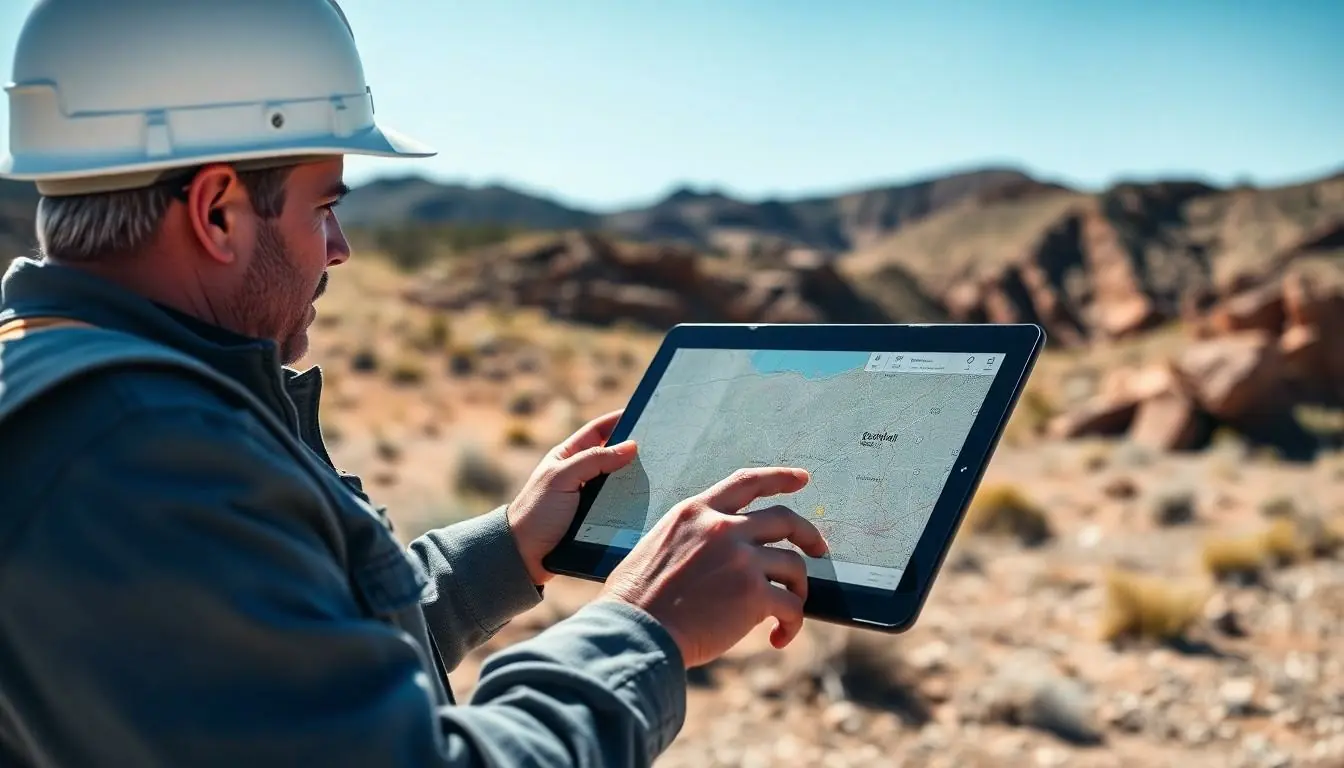In a world where precision meets innovation, the visual land tablet is turning heads and transforming landscapes. Imagine having the power to visualize terrain, analyze data, and make decisions all from a sleek device that fits right in your hands. It’s like having a magic wand for land management—no wands required!
These tablets are not just tech toys; they’re essential tools for professionals in agriculture, surveying, and construction. With cutting-edge features and user-friendly interfaces, they make complex tasks feel like a walk in the park—if that park were meticulously mapped out, of course. Whether you’re plotting out fields or scouting new construction sites, the visual land tablet is your trusty sidekick, ready to help you navigate the great outdoors with ease and a sprinkle of fun.
Table of Contents
ToggleOverview of Visual Land Tablets
Visual land tablets serve as powerful tools across multiple industries, including agriculture, surveying, and construction. These tablets integrate high-resolution displays with advanced software, allowing users to visualize complex terrain and analyze geographical data.
Ease of use characterizes the design of visual land tablets. Most devices feature intuitive interfaces that reduce the learning curve, enabling professionals to focus on their tasks instead of navigating complicated menus. Users can quickly access mapping functions, data overlays, and measurement tools, enhancing productivity.
Applications of visual land tablets extend to field data collection and management. By utilizing GPS technology, these devices facilitate real-time positioning and monitoring, leading to more accurate land assessments. As a result, professionals can make informed decisions that optimize land use and improve project outcomes.
Compatibility with various software platforms enhances the functionality of visual land tablets. Many devices support industry-specific applications, making it easy for users to integrate existing workflows. This flexibility ensures that professionals can leverage the full potential of their data for specific tasks, whether conducting surveys or analyzing crop yields.
Visual land tablets represent a significant advancement in land management technology. With their powerful features and user-friendly design, they enable professionals to visualize land terrain and streamline complex tasks. These tablets ultimately enhance decision-making capabilities and increase efficiency in numerous fields.
Key Features of Visual Land Tablets

Visual land tablets feature several attributes that enhance usability and effectiveness in various industries. These attributes include display quality, performance specifications, and battery life.
Display Quality
High-resolution displays define visual land tablets, providing vibrant colors and sharp imagery. Clarity aids in the accurate visualization of terrain and geographical details. Most tablets offer touchscreen capabilities, promoting user interaction and ease of navigation. Many models are designed with sunlight-readable screens, ensuring visibility even in bright outdoor conditions. Enhanced brightness levels contribute to an improved viewing experience, crucial for fieldwork in varying light contexts.
Performance Specifications
Powerful processors underlie visual land tablets, enabling swift data processing and seamless multitasking. Various models come with ample RAM, facilitating efficient app performance and quick loading times. Most tablets utilize the latest operating systems, offering user-friendly interfaces and access to various applications. Data storage options typically range from 32 GB to 256 GB, accommodating substantial amounts of geographic data and applications. Robust connectivity options, including Wi-Fi and cellular capabilities, support real-time data access and sharing.
Battery Life
Extended battery life characterizes visual land tablets, ensuring reliability during prolonged use in the field. Many devices offer battery longevity exceeding 8 hours, allowing users to work without frequent recharging. Advanced power management features help maximize efficiency, reducing energy consumption during idle times. Quick charging options often accompany devices, minimizing downtime between sessions. Overall, robust battery performance supports comprehensive field tasks without interruption.
Comparison with Other Tablets
Visual land tablets stand out in the crowded tablet market due to their specialized features tailored for land management. Their focus on high-resolution displays and advanced software differentiates them from standard tablets.
Visual Land Tablet vs. Competitors
Visual land tablets outperform general-purpose tablets and competitor devices, especially in applications related to surveying and agriculture. Other tablets might offer similar display technology, but they often lack the robust GPS integration essential for real-time monitoring and accurate land assessments. Moreover, while competitors may excel in tablet functionality, they typically don’t provide the same level of intuitive interfaces found in visual land tablets.
Unique Selling Points
A unique selling point for visual land tablets is their extended battery life, which often exceeds eight hours. This feature significantly enhances their suitability for field use compared to many conventional tablets. Additionally, superior touchscreen responsiveness in bright conditions ensures optimal usability, making these devices more practical for outdoor environments. Access to powerful processors combined with ample RAM fosters seamless data processing, vital for professionals relying on real-time data for decision-making tasks. Compatibility with various software platforms further strengthens their appeal, consolidating workflows and enhancing efficiency.
User Experience
User experience with visual land tablets often reflects their practicality and functionality in the field. Many users appreciate the intuitive interface, which simplifies navigation and enhances productivity.
Feedback from Users
Users frequently commend the vibrant display quality and responsiveness, noting these features significantly improve decision-making in real-time scenarios. Surveyors report that the GPS capabilities provide impressive accuracy, making land assessments more reliable. Agriculture professionals highlight the tablets’ ability to analyze crop yields efficiently, leading to better management practices. Positive experiences with battery longevity also emerge, as extended use without frequent recharging aids in maintaining workflow on-site. Users express satisfaction with seamless integration into existing software platforms, enhancing their overall effectiveness in diverse applications.
Common Issues and Solutions
Some users encounter occasional connectivity challenges, particularly in remote areas. This issue can be addressed by ensuring users have updated firmware and utilizing offline data storage when necessary. Additionally, a few users express concerns about the tablet’s weight during prolonged use. In response, manufacturers are encouraged to consider lighter materials for future models. Users occasionally find touchscreens less responsive in very bright sunlight; they can mitigate this by adjusting brightness settings. By providing these solutions, visual land tablets can enhance usability and user satisfaction, reinforcing their value in land management tasks.
Future of Visual Land Tablets
Visual land tablets are set to evolve significantly in the coming years. Anticipated advancements include improved GPS technology, enabling even more precise location tracking. Enhanced processing capabilities will allow for faster data processing, making real-time analysis seamless and efficient.
Innovations in display technology will result in brighter, more vivid screens that remain readable in various lighting conditions. Users may experience greater interactivity with touchscreens, leading to a more engaging experience in the field. Battery life improvements beyond eight hours could extend usability, reducing downtime during critical tasks.
Integration with emerging technologies will likely expand their applications. For instance, incorporating augmented reality features could revolutionize how professionals visualize terrain and data. Seamless connectivity improvements will address current challenges, ensuring reliable access to cloud resources even in remote locations.
The adoption of lighter materials can enhance mobility, addressing user concerns regarding weight during extended use. Manufacturers may focus on refining software interfaces, making them even more intuitive to streamline tasks further. Enhanced durability against environmental factors will also play a crucial role in their effectiveness in challenging conditions.
These developments demonstrate the commitment to improving visual land tablets, ensuring they stay at the forefront of land management technology. Continued feedback from users will drive enhancements, allowing these devices to meet the evolving needs of professionals in agriculture, surveying, and construction. Overall, the future of visual land tablets promises to enhance productivity and decision-making across multiple industries.
Visual land tablets are revolutionizing the way professionals approach land management. Their advanced features and user-friendly design empower users to make informed decisions quickly and efficiently. As technology continues to advance these devices will likely become even more essential in fields like agriculture surveying and construction.
With ongoing improvements in GPS accuracy and display technology the potential for these tablets to enhance productivity and decision-making is immense. Addressing current challenges will only strengthen their position in the market. As visual land tablets evolve they promise to remain at the forefront of innovation in land management solutions.



